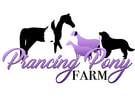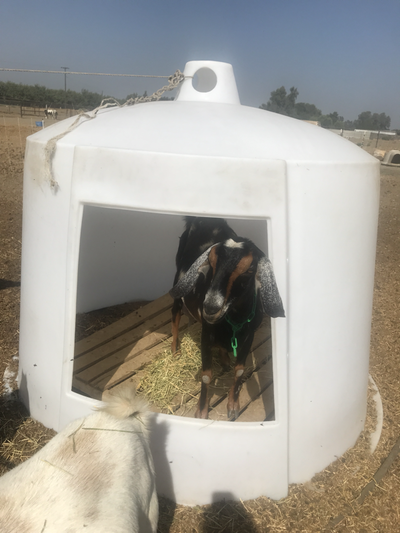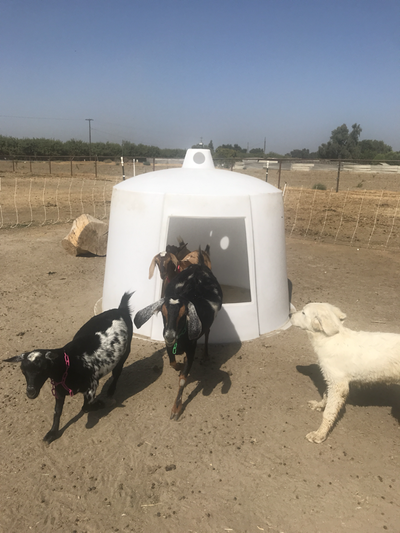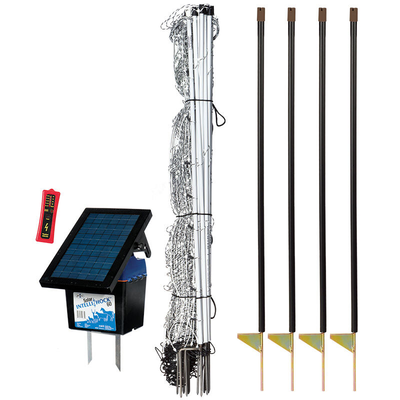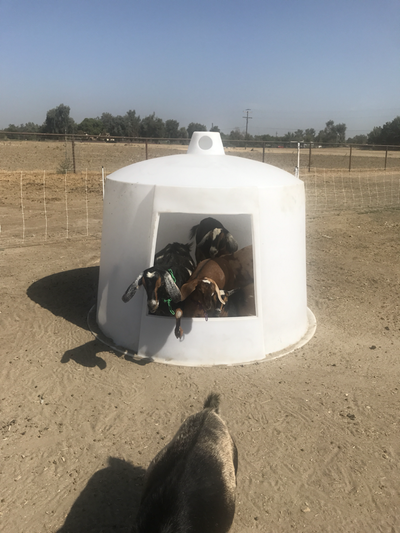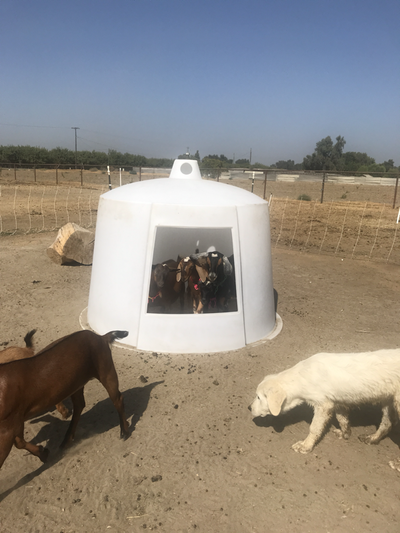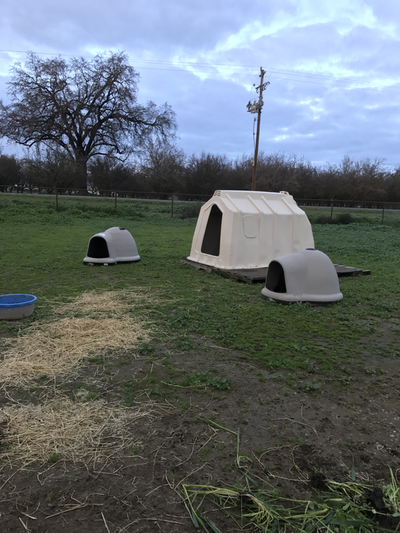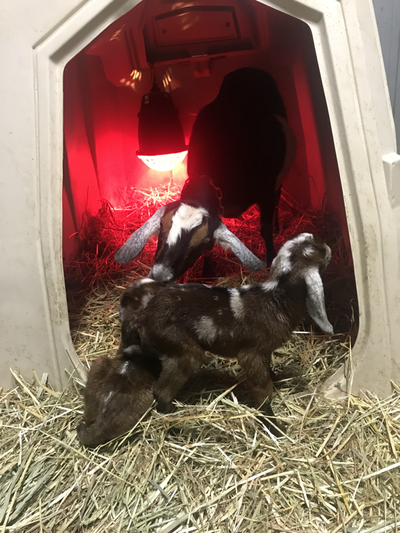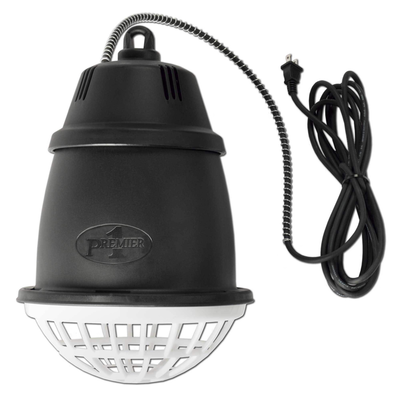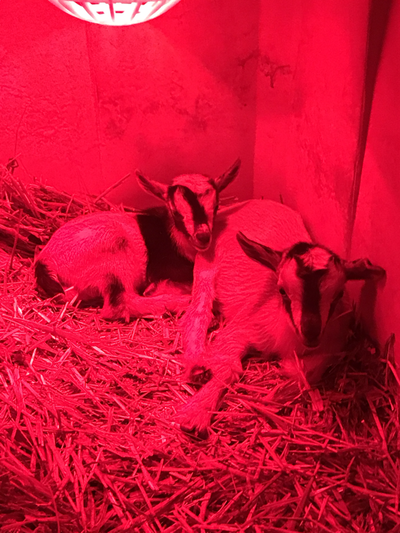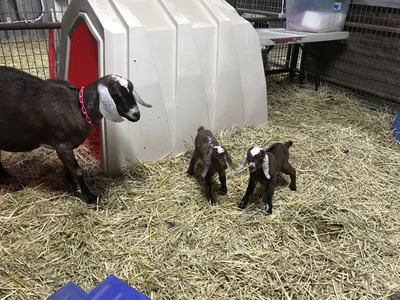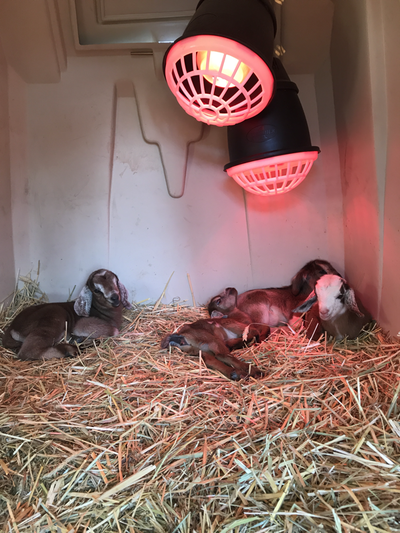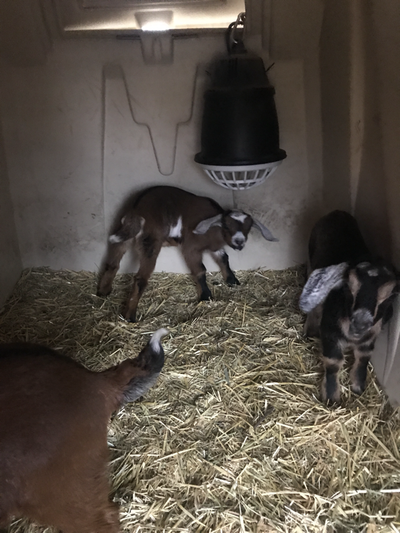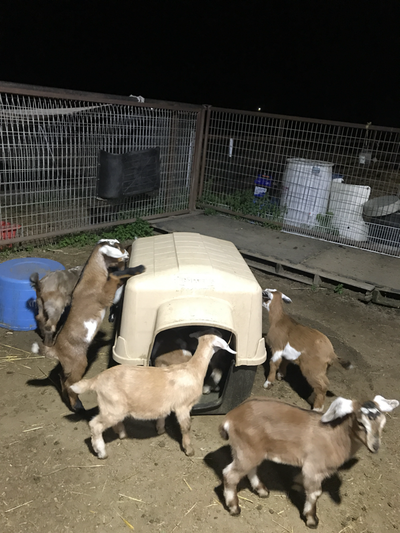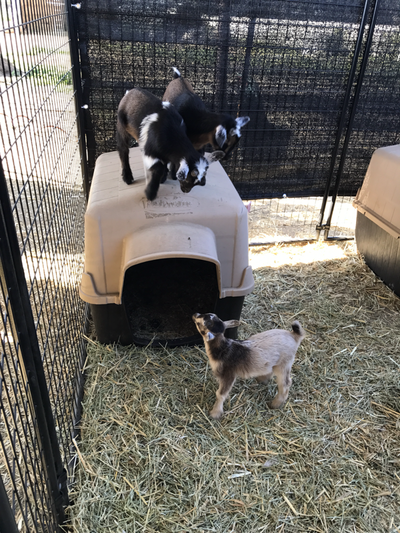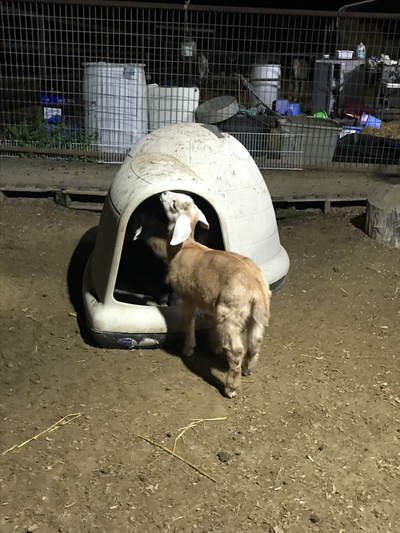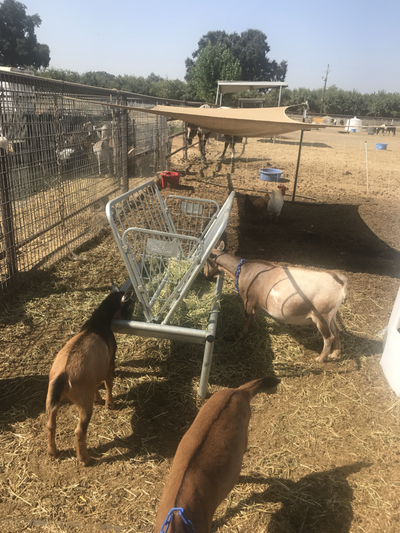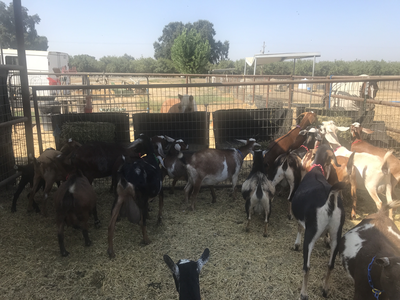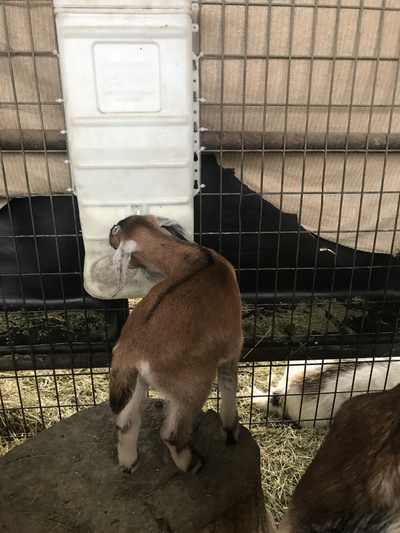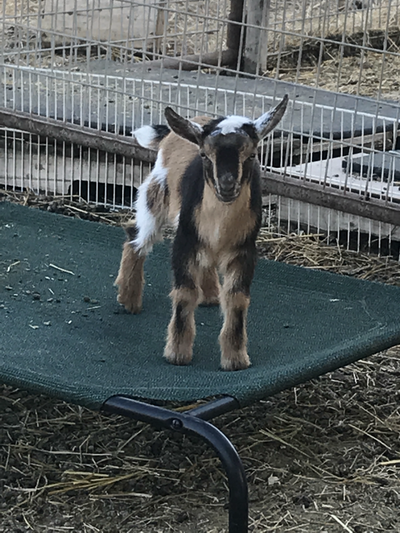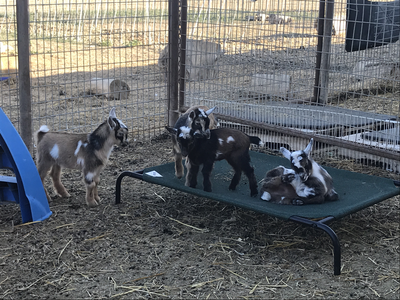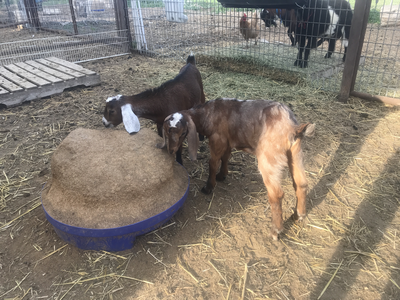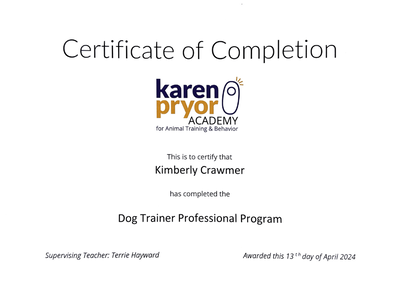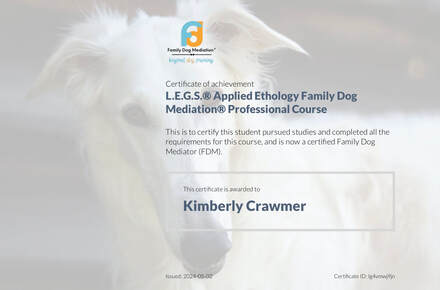Housing Dairy Goat Does and Kids
We prefer to raise our goats in a natural herd environment, while also keeping everyone safe and happy. Therefore we try to breed the does to kid in batches. We have 4 large kidding stalls with attached runs in our converted horse barn. The runs having swinging walls and can each be configured to make from one to five different pens. We also have large pastures fenced with electric goat netting from Premier 1 off the back of the runs. We have several larger calf hutches from Calftel and Polydome out there, as well as lots of logs and toys for playing on. We have our CraftsMin loose minerals in each stall in mineral feeders from Caprine Supply. Hay is fed in various feeders meant to reduce waste. (It doesn't really work!) We use automatic waterers (from Tractor Supply) that we check and clean daily.
When kidding time is near we separate our pregnant does from the main herd into small groups of usually 3-4 does along with their kids.
The stalls are equipped with small Calftel calf hutches as well as large dog houses so the baby goats can keep warm. We particularly like the calf hutches because several kids and even a doe or two can fit into them at once and a Prima heat lamp can be put in the back opening to keep everyone toasty warm. Even we humans are known to crawl in there to play with the babies on cold winter days! (In summer we turn off the heat lamps and run fans on automatic timers.)
We often use the welded wire fence panels from Premier 1 to make temporary kidding jugs for each new mom and her kids to stay in for a day or two to facilitate bonding, particularly with first time moms. These panels come in really handy for building all kids of temporary partitions, fences and enclosures and we have dozens of them in use around the barn. We have a few 6’ panels but mostly 4’ ones as they are the best value per foot and free shipping is included with them.
The does and kids are kept closed into the stall for a few days to a week and then we open up the back run area for them to get more exercise. We provide things for the babies to climb and play on and make sure kids can reach the hay, minerals, and water. We use shallow automatic waterers in the first weeks to prevent accidental drownings.
Over time we may combine groups of does and kids as the kids get bigger but we generally don't put them in with the main herd until the kids are close to weaning age to prevent bullying and stress. We also don't allow them outside the pens into our barnyard and horse pastures until they are big enough not to be stepped on by one of our horses, or try to drown themselves in the water troughs. (Somehow baby goats always manage to bounce right INTO the troughs, which is why we now use shallow troughs.)
We bed the stalls with hay, straw or shavings during the first few weeks and when it's very cold but after that we prefer bare floors because it's easier to keep clean. We rake daily to help control parasites and just put bedding in the calf hutches during this time.
Our Maremma Livestock Guardian Dogs love baby goats and visit with them daily, getting the goat kids used to them from a young age. If we happen to have any Maremma puppies during kidding season they are born right next to the kidding stalls and socialized with the does and kids heavily from birth, making for excellent Livestock Guardian Dogs.
We gradually start separating the does from the kids for a few hours a day, working up to several hours over time. We let the does go out to play with the other goats in the pasture and leave the kids together in the stalls. Then we milk the does at night before putting them back together. This gives the does a break and eases the eventual transition to weaning for the kids, plus gives us more milk. We're flexible with this, though. If it's a busy day or we don't need much milk we sometimes leave the does with the kids and just milk whatever's left at the end of the day. Does with large litters (3-5) we don't start separating until the kids are several weeks old so that we know the babies get all the milk they need. We have found that it's easier on the kids if they get used to their moms leaving them for at least a little while most days than if we wait until they are older to try to start this.
By the time the kids are 3-4 months old (sooner for boys) they can go to their new homes. At this time we will usually start letting any doelings we are retaining go out with their moms and the rest of the herd. They find this very exciting!
When kidding time is near we separate our pregnant does from the main herd into small groups of usually 3-4 does along with their kids.
The stalls are equipped with small Calftel calf hutches as well as large dog houses so the baby goats can keep warm. We particularly like the calf hutches because several kids and even a doe or two can fit into them at once and a Prima heat lamp can be put in the back opening to keep everyone toasty warm. Even we humans are known to crawl in there to play with the babies on cold winter days! (In summer we turn off the heat lamps and run fans on automatic timers.)
We often use the welded wire fence panels from Premier 1 to make temporary kidding jugs for each new mom and her kids to stay in for a day or two to facilitate bonding, particularly with first time moms. These panels come in really handy for building all kids of temporary partitions, fences and enclosures and we have dozens of them in use around the barn. We have a few 6’ panels but mostly 4’ ones as they are the best value per foot and free shipping is included with them.
The does and kids are kept closed into the stall for a few days to a week and then we open up the back run area for them to get more exercise. We provide things for the babies to climb and play on and make sure kids can reach the hay, minerals, and water. We use shallow automatic waterers in the first weeks to prevent accidental drownings.
Over time we may combine groups of does and kids as the kids get bigger but we generally don't put them in with the main herd until the kids are close to weaning age to prevent bullying and stress. We also don't allow them outside the pens into our barnyard and horse pastures until they are big enough not to be stepped on by one of our horses, or try to drown themselves in the water troughs. (Somehow baby goats always manage to bounce right INTO the troughs, which is why we now use shallow troughs.)
We bed the stalls with hay, straw or shavings during the first few weeks and when it's very cold but after that we prefer bare floors because it's easier to keep clean. We rake daily to help control parasites and just put bedding in the calf hutches during this time.
Our Maremma Livestock Guardian Dogs love baby goats and visit with them daily, getting the goat kids used to them from a young age. If we happen to have any Maremma puppies during kidding season they are born right next to the kidding stalls and socialized with the does and kids heavily from birth, making for excellent Livestock Guardian Dogs.
We gradually start separating the does from the kids for a few hours a day, working up to several hours over time. We let the does go out to play with the other goats in the pasture and leave the kids together in the stalls. Then we milk the does at night before putting them back together. This gives the does a break and eases the eventual transition to weaning for the kids, plus gives us more milk. We're flexible with this, though. If it's a busy day or we don't need much milk we sometimes leave the does with the kids and just milk whatever's left at the end of the day. Does with large litters (3-5) we don't start separating until the kids are several weeks old so that we know the babies get all the milk they need. We have found that it's easier on the kids if they get used to their moms leaving them for at least a little while most days than if we wait until they are older to try to start this.
By the time the kids are 3-4 months old (sooner for boys) they can go to their new homes. At this time we will usually start letting any doelings we are retaining go out with their moms and the rest of the herd. They find this very exciting!
If you are local you can buy Calftell calf huts from Ron Kuber in Clovis. His number is (559) 779-5961 (cell) or (559) 323-9611 (main).
